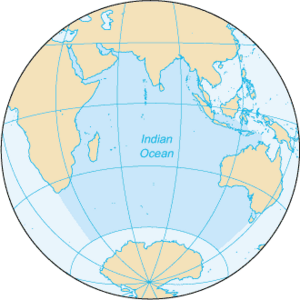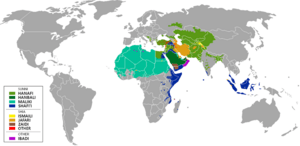Shafi'i school facts for kids
The Shafi'i school (Arabic: شَافِعِي, romanized: Shāfiʿī, also spelled Shafei), or Madhhab al-Shāfiʿī, is one of the four main traditional ways of understanding Islamic law in the Sunni branch of Islam. It was started by an Arab scholar named Muḥammad ibn Idrīs al-Shāfiʿī in the early 800s. He is often called "the father of Muslim law."
The other three main Sunni law schools are Ḥanafī, Mālikī, and Ḥanbalī. Like these other schools, the Shafi'i school believes the First Four Caliphs were the rightful leaders after the Islamic prophet Muhammad. It gets its laws mainly from the Qurʾān (Islam's holy book) and reliable Ḥadīths (sayings and actions of Prophet Muhammad). The Shafi'i school uses both divine laws (from the Qurʾān and Sunnah) and human thinking to understand the law. If parts of the Qurʾān or Ḥadīths are not clear, the school uses Qiyās, which is like using similar past cases to figure out new ones. The idea of Ijmā' (agreement among scholars or the community) was accepted but not emphasized much. This school did not rely on local traditions for legal rules and did not accept personal opinions or individual choices of judges as sources of law.
The Shafi'i school was very popular in the Middle East until the Ottomans and Safavids came to power. Traders and merchants helped spread Shafi'i Islam across the Indian Ocean, reaching places like India and Southeast Asia. Today, the Shafi'i school is mostly found in parts of Hejaz and the Levant, Lower Egypt and Yemen, among the Kurdish people, in the North Caucasus, and around the Indian Ocean (like the Horn of Africa and the Swahili Coast in Africa, and coastal South Asia and Southeast Asia).
Contents
How Shafi'i Law Works
The main idea of Shafi'i thinking is that every action a Muslim does has a rule in the Revealed Law, also known as the Shari'a. This rule is either directly stated in the Qurʾān or the Sunnah, or it can be figured out from them using Qiyas (analogical reasoning).
Al-Shafi'i was the first legal scholar to say that Ḥadīth were the most important source of law, even more important than older traditions. Here are the sources of law, in order of importance, according to the Shafi'i school:
Main Sources
- Qurʾān — This is the holy book of Islam.
- Sunnah — This means the sayings, actions, and approvals of Prophet Muhammed, as told in strong, reliable traditions.
The school did not rely on local community practices as a source for legal rules.
Thinking and Agreement
- Qiyas with Legal Proof or Dalil Shari'a — This is using similar cases to figure out new legal rules based on the Qurʾān and the Sunnah.
- Analogy by Cause (Qiyas al-Ma'na/Qiyas al-Illa)
- Analogy by Resemblance (Qiyas al-Shabah)
- Ijmā' — This is the agreement of scholars or the community. It was accepted but not heavily relied upon.
Later Shafi'i scholars also introduced the idea of Istishab, which means assuming something stays the same unless there's proof it changed. Al-Shafi'i also taught that punishments should be dropped if someone truly repents before being punished.
The Book Risālah
The main legal book for Shafi'i law is al-Shafiʽi's al-Risala, which means "the Message." He wrote it in Egypt. This book explains the main ideas of Shafi'i legal thinking and how laws are figured out. An earlier version of the Risālah, called al-Risalah al-Qadima, which al-Shafi'i wrote in Baghdad, is now lost.
Differences from Other Schools
Al-Shāfiʿī strongly disagreed with the idea of simply following old judicial customs without question.
Compared to the Mālikī View
- The Shafi'i school argued that many local traditions might not truly reflect what Prophet Muhammed did. So, according to Shafi'i understanding, local traditions cannot be used as sources of law. This was a criticism of the Mālikī school's approach.
Compared to the Ḥanafī View
- The Shafi'i school rejected Ahl al-Ra'y (personal opinion) and Istiḥsān (a judge's personal choice). It insisted that legal rules could not be used without strong proof from texts. The school did not accept ideas that had no basis in the Qurʾān or Ḥadīths, but were only based on the opinions of Islamic scholars.
- Shafi'i thinkers believed that using personal opinions could make people replace God and Prophet Muhammad, who are the only true lawmakers. They felt that true knowledge and correct understanding of religious duties would suffer from unfair judgments based on mistakes.
History of the Shafi'i School

Al-Shāfiʿī (who lived from about 767 to 820 AD) traveled to many important centers of Islamic law in the Middle East. He learned a lot about different ways of thinking about legal theory. He was a student of important scholars like Malik ibn Anas, who started the Mālikī school, and Muhammad al-Shaybani, a great Ḥanafī scholar in Baghdad.
- The Shafi'i ideas were first spread by Al-Shafi'i's students in Cairo and Baghdad. By the 900s, the holy cities of Mecca and Medina and Syria also became major centers for Shafi'i ideas.
- Later, the Shafi'i school held all the judgeships in Syria, Kirman, Bukhara, and Khorasan. It also grew strong in Northern Mesopotamia and Daylam. The Ghurids also supported the Shafi'is in the 1000s and 1100s AD.
- Under Salah al-Din, the Shafi'i school became the most important way of thinking in Egypt again. (Before this, Egypt had been more influenced by Shi'a ideas). It was the "official school" of the Ayyubid dynasty and stayed important during the Mamlūk period too. Baybars, a Mamlūk sultan, later appointed judges from all four main schools in Egypt.
- Traders and merchants helped spread Shafi'i Islam across the Indian Ocean, reaching places like India and Southeast Asia.
Under the Ottomans and Safavids
- When the Ottomans rose to power in the 1500s, they replaced Shafi'i judges with Ḥanafī scholars.
- Under the Safavids, the Shafi'i school's importance in Central Asia was replaced by Shi'a Islam.
Where Shafi'i is Found Today
The Shafi'i school is mainly found in these parts of the world today:
- Middle East and North Africa: Parts of Hejaz, the Levant (Palestine, Jordan, and many people in Syria, Lebanon, and Iraq), Lower Egypt, among Sunnis in Iran and Yemen, and the Kurdish people.
- Eurasia: Northern Azerbaijan, Dagestan, Chechen and Ingush regions of the North Caucasus.
- Around the Indian Ocean:
The Shafi'i school is one of the largest Sunni schools in terms of how many people follow it. We don't have exact numbers for each country, so the sizes are estimates.
Famous Shafi'i Scholars
In Hadith studies:
In Tafsir (Qur'an explanation):
|
In Fiqh (Islamic law):
In Usul al-Fiqh (principles of Islamic law):
In Arabic language studies:
In Theology:
|
In Philosophy:
In Sufism
In history
|
Modern Shafi'i Scholars
From Middle East and North Africa:
- Ahmed Kuftaro
- Ali Gomaa
- Habib Umar bin Hafiz
- Abdullah al-Harari
- Ali al-Jifri
- Mohammad Salim Al-Awa
- Wahba Zuhayli
- Taha Jabir Alalwani
- Taha Karaan
From Southeast Asia:
- Afifi al-Akiti
- Ahmad Syafi'i Maarif
- Hasyim Muzadi
- Syed Muhammad Naquib al-Attas
From South Asia:
- Muhammad Jifri Muthukkoya Thangal
- Tajul Ulama
- K. Ali Kutty Musliyar
- Kanniyath Ahmed Musliyar
- E. K. Aboobacker Musliyar
- Zainuddin Makhdoom II
- Sheikh Abubakr Ahmad
- Cherussery Zainuddeen Musliyar
- Varakkal Mullakoya Thangal
See also
 In Spanish: Shafi'i para niños
In Spanish: Shafi'i para niños


